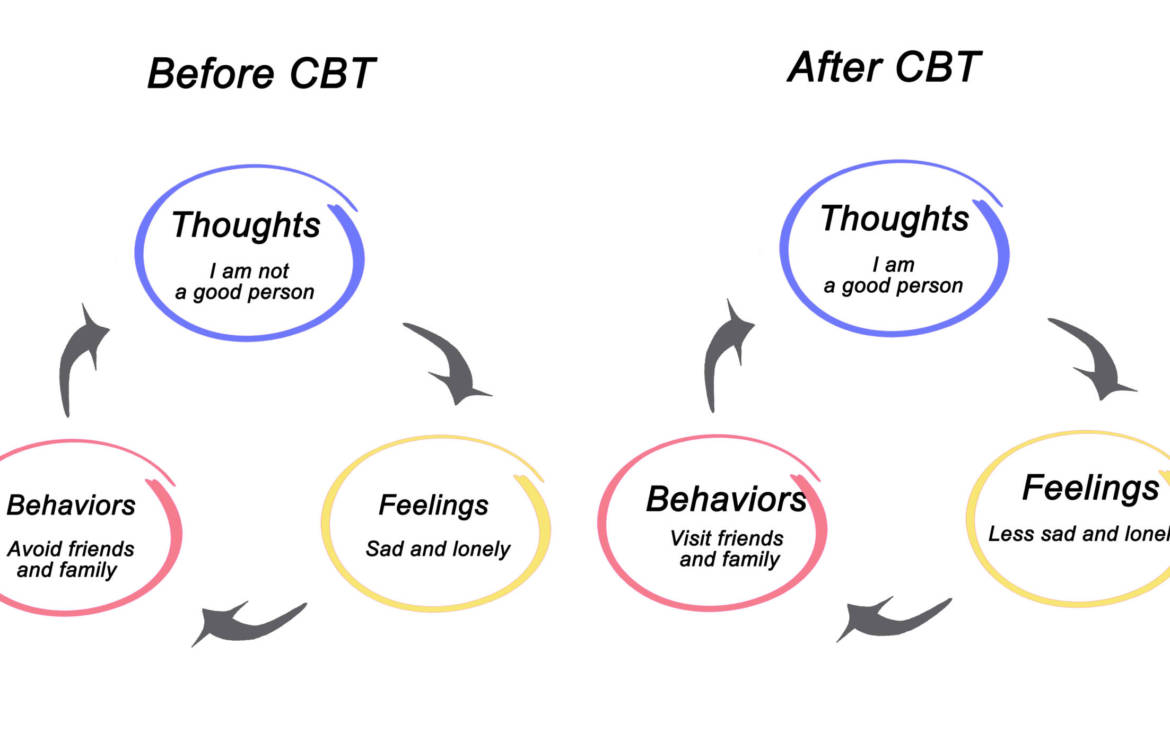What is CBT and what is it useful for?
CBT or Cognitive Behavioral Therapy is a popular form of psychotherapy that was developed in the 60s by Dr. Aaron Beck, a psychiatrist at the University of Pennsylvania. Dr. Beck discovered while working with his patients, that for many, automatic thoughts got in their way. He developed CBT to help each patient recognize this pattern and to help them to think in a more realistic manner that he could effectuate long-term positive changes. CBT teaches patients or clients specific skills which they can use themselves throughout their lives, thus not having to depend on therapy on a long-term basis.
CBT is widely used today by psychologists, counsellors, and other mental health professionals including life coaches. It has become a popular choice in the treatment of depression, anxiety, anger management, and addiction – just to name a few of the areas where it has been proven to be effective due to its sound empirical basis. It blends two schools of thought in psychology – cognitive theory and behavioral theory. It’s a time-limited and structured approach that has been proven to have quick and long-lasting results if done properly.
CBT is based on the idea that people can get better by making small changes in their thinking and behavior every day. Therapy sessions are structured and oriented towards helping the client to have a better week. The therapist or practitioner gives the client tools to help themselves to monitor their own thinking.
CBT is based on the Cognitive Model which considers a situation and the automatic thoughts that it produces, as well as the individual’s reactions. It basically concentrates on the person’s perception of the situation which impacts how the person feels by producing automatic thoughts. Automatic thoughts may be true but unhelpful. The purpose of CBT is not to eliminate thoughts but to recognize them and understand the core beliefs and assumptions which lie at a deeper level. Assumptions may be expressed in the form of rules or attitudes. The practitioner’s role is to gather information to help the client assess their own beliefs and then to develop a different relationship with their thoughts by focusing on the underlying beliefs about their thoughts.
The Cognitive Model

(taken from the Beck Institute)
The Cognitive Model helps the practitioner to make sense of their clients’ experience. It helps explain why people think and act as they do because it gets down to the root of their perceptions of a given situation. It looks at the automatic thoughts that pop up and the reactions that result based on the client’s thinking. It helps the practitioner to understand how the client sees himself or herself, as well as how they see others and the world around them.
The therapist or practitioner applies Socratic questions to help the client to evaluate the validity of the client’s thoughts. They question what evidence the person has that the thought is true, and whether there is evidence to the contrary. They would also see if the client could look at the situation in another way.
The practitioner asks the client to consider the worst possible outcome and then the best possible thing that could happen. The client is asked what the most realistic outcome is. They may ask the client what they would say to a friend or colleague if they were in the same situation with the same thoughts. The client is asked what advice they would give the friend or colleague.
The goal of CBT is to get the client to see that their negative self-critical and self-depreciating thoughts which are often automatic and preconscious thinking are unreasonable or illogical. The practitioner does not tell the client this, however. They act as the facilitator who guides the client to make their own decisions. They teach the client to repeat the same processes on their own so that they can independently help themselves in the future.
Automatic thoughts are the most superficial level of cognition. At a deeper level lie our core beliefs and assumptions. People don’t pay much attention to them. Some are positive and others are negative. They can trigger euphoria or sadness. They are brief and fleeting and arise spontaneously without even trying to think about them. Negative automatic thoughts often get in the client’s way of achieving their goals. If the client is able to recognize them and find new ways to deal with them, they may experience a shift in affect resulting in a brighter future. Therefore, the purpose of the practitioner is to help make the unconscious thoughts, which the client is unaware of, conscious.
The practitioner’s job is to identify the cognitive distortions which get in the client’s way of performing to their fullest potential. Some of these distortions could be as follows:
- Fortune Telling – making predictions about what will happen when other outcomes are more likely.
- All or nothing thinking – you see the world in black and white and overlook the possibility of shades of grey.
- Labelling – putting a globally negative label on yourself such as “I am incompetent” or “I am a failure.”
- Emotional Reasoning – you believe something must be true because it feels true such as, “I must be a incompetent, “ or “Trying is useless.”
- Selective Abstractraction – you pay attention to only negative thoughts instead of considering the whole experience. For example: “I screwed up again. I made too many mistakes.”
- Over-generalization – you draw a universal conclusion based on a small amount of evidence. For example: “I can never do anything right.”
- Mind reading – you are sure you know what others are thinking. Ex: “They probably think I am an idiot.”
- Personalization – You take the actions of others personally and assume you know their intentions. Ex: “They did that to exclude me.”
- Imperatives – You have unreasonable expectations of others and/or yourself. Ex: “I should always work harder.”
- Magnification and Minimization – you magnify the negative and minimize the positive. Ex: “It doesn’t matter that I am well-educated because I lack common sense. I am a food.”
Adapted from the book “Cognitive Behavioral Therapy” by Dr. Judith Beck.
The role of the practitioner is to ask but not to tell the patient what to think or conclude. Clients effectuate more positive change if they come up with things themselves. The practitioner’s role is simply to get clients to look at the data themselves and draw their own conclusions. The desired result of the sessions is to get clients to learn to question themselves and evaluate their automatic thoughts by themselves.
Outside of sessions, the practitioner may fill out a Cognitive Conceptualization Model to strategize on what might be best to focus on in upcoming sessions.
About Amy Sindicic
I am trained in CBT for coaching and have studied under Dr. Judith Beck, the daughter of Aaron Beck. If you are interested in learning more, please feel free to book a 30-minute FREE CONSULTATION: https://geishafawn.simplybook.me/v2/#book/category/3/count/1/.
I look forward to meeting you and discussing whether or not this is right for you.




